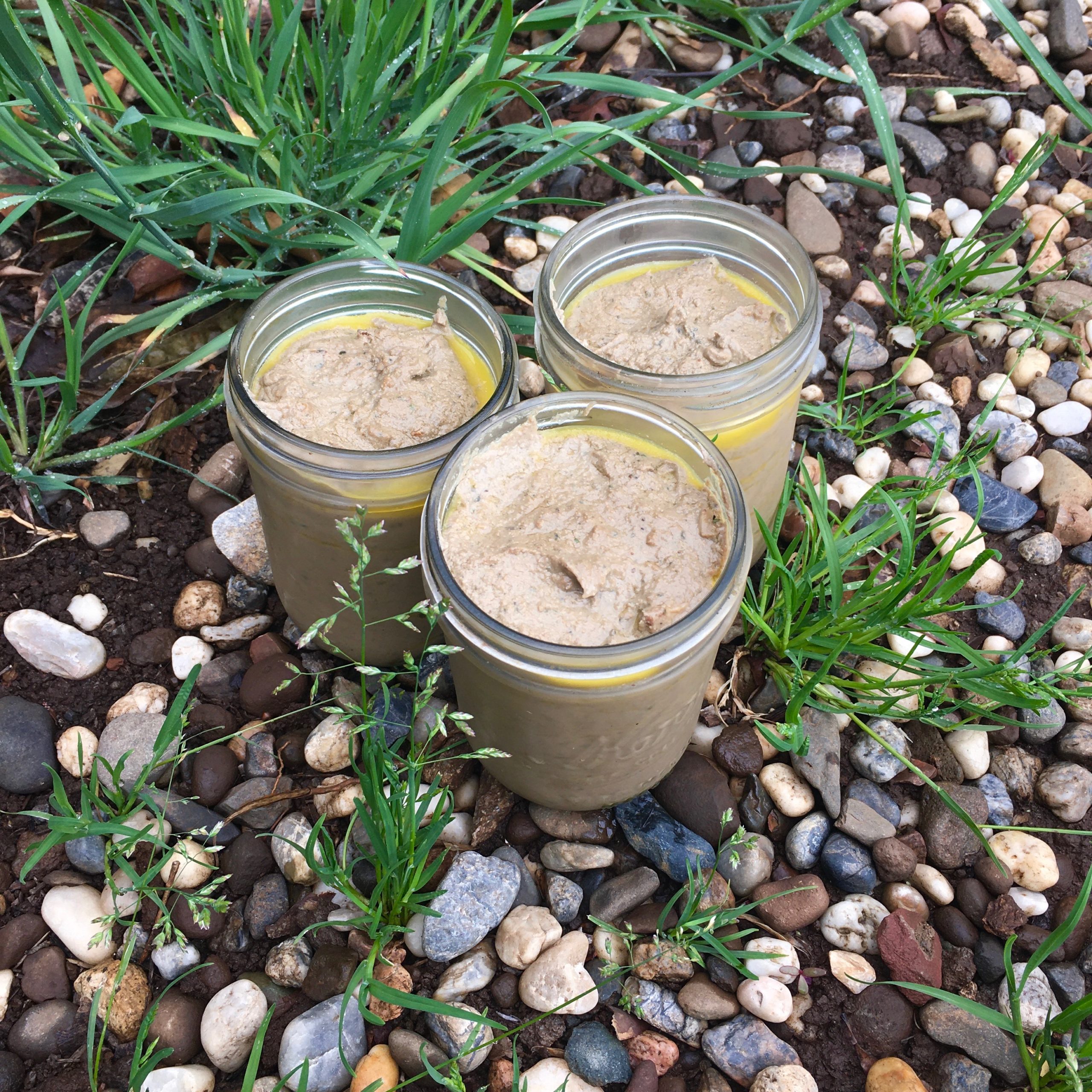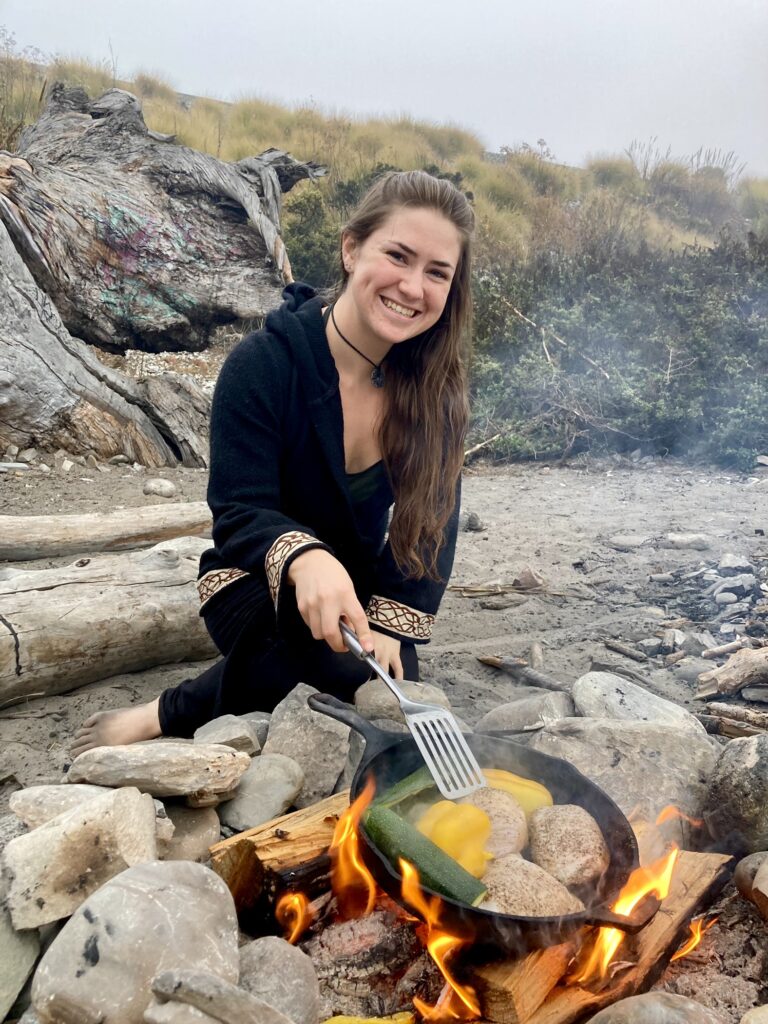Overcome Your Gut + Digestive Issues With Ancestral Nutrition
Bacon Beef Liver (And Heart) Pâté

I had never thought of eating organs, at least not until it was recommended to me by a dietitian. The dietitian recommended including liver in my diet to help raise my low iron levels. The liver is responsible for storing iron, therefore you get a lot of dietary iron from consuming liver. Liver is also rich in retinol vitamin A and copper which are both necessary for iron absorption and utilization. (Heart is also a great source of iron for similar reasons). Organ meats in general are extremely nutrient dense foods, they are like natures multivitamins!
A 3 Oz Serving Of Beef Liver Contains Approximately:
- 534% of your RDA (recommended daily allowance) of Retinol Vitamin A
- 168% of your RDA of Vitamin B2
- 54% of your RDA of Folate
- 987% of your RDA of Vitamin B12
- 30% of your RDA of Iron
- 600% of your RDA of Copper
- 42% of your RDA of Selenium
- 30% of your RDA of Zinc
- 357 mg of Choline
A 3 Oz Serving Of Beef Heart Contains Approximately:
- 24% of your RDA of Retinol Vitamin A
- 142% of your RDA of Vitamin B2
- 29% of your RDA of Vitamin B3
- 68% of your RDA of Iron
- 22% of your RDA of Phosphorus
- 24% of your RDA of Copper
- 48% of your RDA of Selenium
- 17% of your RDA of Zinc
- 36% of your RDA of Choline
(3)
How To Cook Liver Right:
Cooking heart is pretty straight forward, but liver is very finicky. Overcook it and it turns grainy and tastes metallic. But cook it just right and add the right seasoning, and it’s creamy and delicious. How well you cook liver really makes or breaks it so here are some tips to nail your liver cooking:
- Don’t over cook it!!!!!!!!!!!!!! Like I mentioned above, overcooked liver is grainy, metallic tasting, and just bad. Make sure you leave a little pink in the middle for a more pleasant texture and taste. (1)
- Add complementing seasonings. This recipe includes bacon, thyme, and oregano which help to offset the strong liver taste.
- Soak the liver first. You can use either lemon juice or milk for this. In this recipe I use milk because I think it goes better. Also I rinse it with water both before and after soaking. (1, 4)
I originally posted this recipe as just a liver pâté, however for the last year or so I’ve been making it as a liver and heart pâté so I’ve updated the recipe to give you the option to make it either way. I personally prefer the liver heart combo as it’s less metallic tasting and better balanced nutrition wise. None the less, it’s great both ways and I hope you enjoy the recipe!
With love from my kitchen to yours,
Kayley
P.S. If you would like to make homemade bone broth for this, I have a recipe for bone broth that you can check out here.

Bacon Beef Liver (And Heart) Pâté
This recipe makes a little over 4 cups. I recommend eating about 1-4 tbsp a day. Aim for the higher end if you're larger, don't eat other organs, and/or are aiming to increase your nutrient stores (like in the case of preparing for pregnancy).
Take bacon (and heart if using) out of the fridge and let it come to room temperature (this will help it cook evenly).
Then rinse liver in water, transfer to a small bowl, and cover with milk. Cover bowl and let soak for 30 minutes in the fridge. Then rinse, drain, and cut into 1.5 cm x 1.5 cm x 0.5 cm pieces. If using heart, cut into the same sized chunks as well.
Next cook the bacon. Lay the bacon strips out on a cold pan so they are not crowded or overlapping. Heat pan over medium heat. Cook for about 8- 12 minutes, flipping occasionally, till golden brown and lightly crisp. Then set aside.
Meanwhile, melt the butter in a small pot over medium-hig heat.
Pour off excess bacon grease, but leave a little in the pan to cook the garlic. Over medium heat, sauté the garlic, while stirring frequently, in the bacon grease for about a minute, till golden brown. Then set aside.
Increase heat to medium high and add the drained liver (and heart if using). Cook on each side for about 2-4 minutes till the inside is still pink when cut into (the internal temperature should be about 155 degrees Fahrenheit). Be careful not to overcook the liver. Over cooking liver makes it grainy and tough. Once done set aside for 5 minutes (Save any juices that seeped out while cooking to add to the pâté as well).
Then add all the ingredients to a blender or food processor and blend till very smooth (Chunky pâté is not good, so blend well). If you wish, you can reserve 2 pieces of bacon, chop them up and mix into the pâté at the very end. This will give you chunks of bacon in the smooth pâté.
Transfer to a jar or tupperware and chill. Serve cold on crackers or sourdough toast, on the side of a meal, or however you like it. I like to eat 2 Tbsps a day with a meal. I think of it like taking a tasty vitamin.
Ingredients
Directions
Take bacon (and heart if using) out of the fridge and let it come to room temperature (this will help it cook evenly).
Then rinse liver in water, transfer to a small bowl, and cover with milk. Cover bowl and let soak for 30 minutes in the fridge. Then rinse, drain, and cut into 1.5 cm x 1.5 cm x 0.5 cm pieces. If using heart, cut into the same sized chunks as well.
Next cook the bacon. Lay the bacon strips out on a cold pan so they are not crowded or overlapping. Heat pan over medium heat. Cook for about 8- 12 minutes, flipping occasionally, till golden brown and lightly crisp. Then set aside.
Meanwhile, melt the butter in a small pot over medium-hig heat.
Pour off excess bacon grease, but leave a little in the pan to cook the garlic. Over medium heat, sauté the garlic, while stirring frequently, in the bacon grease for about a minute, till golden brown. Then set aside.
Increase heat to medium high and add the drained liver (and heart if using). Cook on each side for about 2-4 minutes till the inside is still pink when cut into (the internal temperature should be about 155 degrees Fahrenheit). Be careful not to overcook the liver. Over cooking liver makes it grainy and tough. Once done set aside for 5 minutes (Save any juices that seeped out while cooking to add to the pâté as well).
Then add all the ingredients to a blender or food processor and blend till very smooth (Chunky pâté is not good, so blend well). If you wish, you can reserve 2 pieces of bacon, chop them up and mix into the pâté at the very end. This will give you chunks of bacon in the smooth pâté.
Transfer to a jar or tupperware and chill. Serve cold on crackers or sourdough toast, on the side of a meal, or however you like it. I like to eat 2 Tbsps a day with a meal. I think of it like taking a tasty vitamin.
Notes
Nutrition:
Pâté With Just Liver:
| Ingredients | Calories | Fat | Carbs | Protein |
| 1.5 lbs beef liver | 960 | 24g | 24g | 132g |
| 6 strips bacon | 322.2 | 24g | 1.2g | 24g |
| 14 Tbsp butter (196g) | 1,400 | 154g | 0g | 0g |
| 1/2 cup Bone broth (100g) | 20.5 | 0.2g | 0.3g | 4.7g |
| 1/4 cup whole milk | 37.5 | 2g | 3g | 2g |
| Total (67.2 Tbsps) | 2,740.2 | 204.2g | 28.5g | 162.7g |
| 1 Tbsp | 40.8 | 3g | 0.4g | 2.4g |
(3)
Pâté With Liver And Heart:
| Ingredients | Calories | Fat | Carbs | Protein |
| 0.75 lbs beef liver | 480 | 12g | 12g | 66g |
| 0.75 lbs beef heart | 342 | 10.2g | 0g | 61.9g |
| 6 strips bacon | 322.2 | 24g | 1.2g | 24g |
| 14 Tbsp butter (196g) | 1,400 | 154g | 0g | 0g |
| 1/2 cup Bone broth (100g) | 20.5 | 0.2g | 0.3g | 4.7g |
| 1/4 cup whole milk | 37.5 | 2g | 3g | 2g |
| Total (67.2 Tbsps) | 2,602.2 | 202.4g | 16.5g | 158.6g |
| 1 Tbsp | 38.7 | 3g | 0.2g | 2.4g |
Notes:
* Nutrition is based on the products I use. I provide a nutrition table so that you can quickly check to see if your food products match or so that you can easily calculate the nutrition for any changes you want to make to the recipe. I think this helps if you have very specific diet, fitness, and/or health goals. I also wanted you to be able to see exactly where I get the numbers for my nutrition facts so that you can see that they are reliable and learn more about macro breakdowns of food.
Works Cited
1. Schoenfeldrd, Laura, “Hate Liver? Eat it Anyway with These Tips.” lauraschoenfeldrd.com. 14 January 2015. https://lauraschoenfeldrd.com/hate-liver-eat-it-anyway-with-these-tips-paleo/
2. Rowles, Alexandra. “Why Liver Is a Nutrient-Dense Superfood.” Healthline. 7 June 2017. https://www.healthline.com/nutrition/why-liver-is-a-superfood
3. Nutritionix. Accessed 11 April 2020. https://www.nutritionix.com/
4. Decker, Fred. “How Long Should Beef Liver Be Cooked?” Our Everyday Life. Accessed 24 November, 2019. https://oureverydaylife.com/long-should-beef-liver-cooked-23262.html
5. Calorie King. Accessed 1 September 2021. https://www.calorieking.com/

